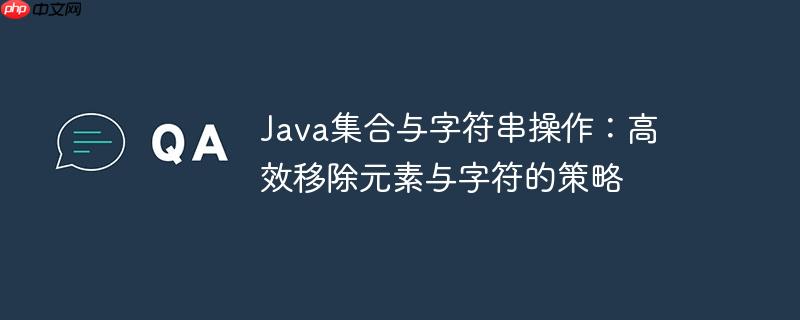
在Java中,当需要从一个集合(如List)中移除满足特定条件的元素时,有多种方法可以选择。然而,不当的使用方式可能导致代码冗余或逻辑错误。
考虑以下原始代码,其目的是生成一个不包含3的倍数的数字序列:
static void printFolgenOhne3(int anz) {
List<Integer> item = new ArrayList<>();
List<Integer> remove;
item.add(anz); // 错误:只添加了参数anz,而不是生成序列
remove = item.stream()
.filter(i -> anz % 3 == 0) // 错误:过滤条件使用了外部变量anz,而不是流中的元素i
.collect(Collectors.toList());
item.removeAll(remove);
item.forEach(System.out::println);
}这段代码存在几个关键问题:
Java 8引入的List.removeIf()方法是移除集合中满足特定条件的元素的最佳实践。它接受一个Predicate函数式接口,并直接在原集合上进行修改,无需创建中间集合。
立即学习“Java免费学习笔记(深入)”;
示例:从现有列表中移除3的倍数
import java.util.ArrayList;
import java.util.Arrays;
import java.util.List;
public class CollectionRemovalExample {
public static void main(String[] args) {
// 示例数据:一个包含数字的列表
List<Integer> numbers = new ArrayList<>(Arrays.asList(1, 2, 3, 4, 5, 6, 7, 8, 9, 10, 11, 12, 13, 14, 15));
System.out.println("原始列表: " + numbers);
// 使用 removeIf 移除所有3的倍数
numbers.removeIf(element -> element % 3 == 0);
System.out.println("移除3的倍数后的列表: " + numbers); // 输出: [1, 2, 4, 5, 7, 8, 10, 11, 13, 14]
}
}removeIf()方法的优点在于:
如果目标是生成一个从特定数字开始、不包含3的倍数的序列,可以使用Java 8的Stream API配合IntStream.iterate()或Stream.iterate()。
示例:生成从4开始,不包含3的倍数的序列
import java.util.List;
import java.util.stream.Collectors;
import java.util.stream.IntStream;
public class SequenceGenerationExample {
/**
* 生成一个从指定起始值开始,不包含3的倍数的数字序列。
*
* @param start 起始值
* @param count 要生成的序列长度
* @return 包含所需数字的列表
*/
public static List<Integer> generateSequenceWithoutMultiplesOfThree(int start, int count) {
return IntStream.iterate(start, n -> n + 1) // 从start开始,每次加1
.filter(n -> n % 3 != 0) // 过滤掉3的倍数
.limit(count) // 限制序列长度
.boxed() // 将IntStream转换为Stream<Integer>
.collect(Collectors.toList()); // 收集到List中
}
public static void main(String[] args) {
// 生成从4开始,长度为10的序列,不包含3的倍数
List<Integer> sequence = generateSequenceWithoutMultiplesOfThree(4, 10);
System.out.println("生成的序列: " + sequence); // 预期输出: [4, 5, 7, 8, 10, 11, 13, 14, 16, 17]
}
}这种方法更符合原始问题中“返回以下序列”的意图,它通过流式操作生成并过滤出符合条件的元素。
当需要从字符串中移除特定字符(如空格)时,字符串本身的方法通常比将其转换为集合再操作更高效和直接。
以下是原始代码中尝试移除字符串空格的尝试:
static void deleteBlanks(String s1) {
List<String> elements = new ArrayList<>();
elements.add(s1); // 列表只包含一个字符串
List<String> deleted = elements
.stream()
.filter(x -> !x.isBlank()) // 错误:isBlank()检查整个字符串是否为空白,而不是字符
.collect(Collectors.toList());
System.out.println(deleted); // 打印的仍然是包含原始字符串的列表
}这段代码的问题在于:
Java的String类提供了强大的方法来处理字符串内容,其中replace()和replaceAll()是移除或替换字符的理想选择。
示例:移除字符串中的所有空格
public class StringManipulationExample {
/**
* 移除字符串中的所有空格。
*
* @param s 原始字符串
* @return 移除空格后的字符串
*/
public static String removeAllSpaces(String s) {
// 使用 replace() 方法替换所有空格字符
return s.replace(" ", "");
}
/**
* 移除字符串中的所有空白字符(包括空格、制表符、换行符等)。
*
* @param s 原始字符串
* @return 移除空白字符后的字符串
*/
public static String removeAllWhitespace(String s) {
// 使用 replaceAll() 方法结合正则表达式 s 匹配所有空白字符
return s.replaceAll("\s", "");
}
public static void main(String[] args) {
String originalString = "Hello world, how are you?";
System.out.println("原始字符串: " + originalString);
String noSpaces = removeAllSpaces(originalString);
System.out.println("移除空格后的字符串: " + noSpaces); // 输出: Helloworld,howareyou?
String anotherString = " Java Streams
Are Powerful! ";
System.out.println("另一个字符串: " + anotherString);
String noWhitespace = removeAllWhitespace(anotherString);
System.out.println("移除所有空白字符后的字符串: " + noWhitespace); // 输出: JavaStreamsArePowerful!
}
}在Java中处理集合和字符串时,选择合适的工具至关重要。
理解这些方法的正确用法和适用场景,能够帮助我们编写出更健壮、更高效的Java代码。
以上就是Java集合与字符串操作:高效移除元素与字符的策略的详细内容,更多请关注php中文网其它相关文章!

每个人都需要一台速度更快、更稳定的 PC。随着时间的推移,垃圾文件、旧注册表数据和不必要的后台进程会占用资源并降低性能。幸运的是,许多工具可以让 Windows 保持平稳运行。

Copyright 2014-2025 https://www.php.cn/ All Rights Reserved | php.cn | 湘ICP备2023035733号